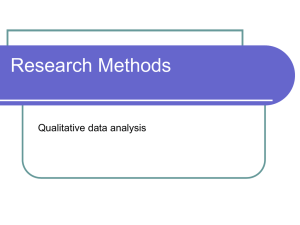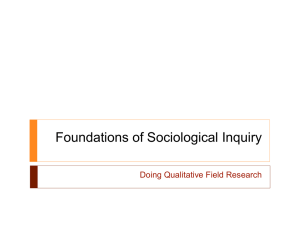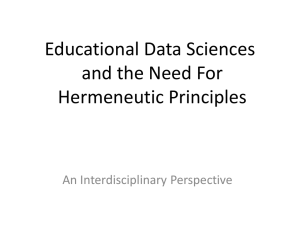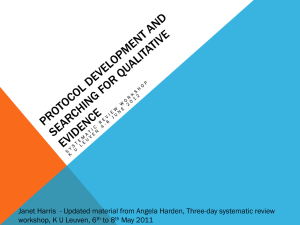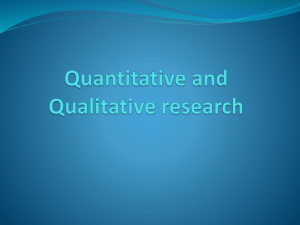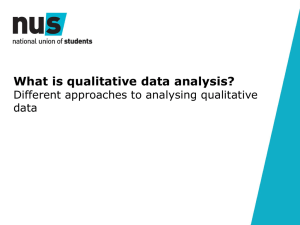Presentation of Prof. Melissa Graebner
advertisement
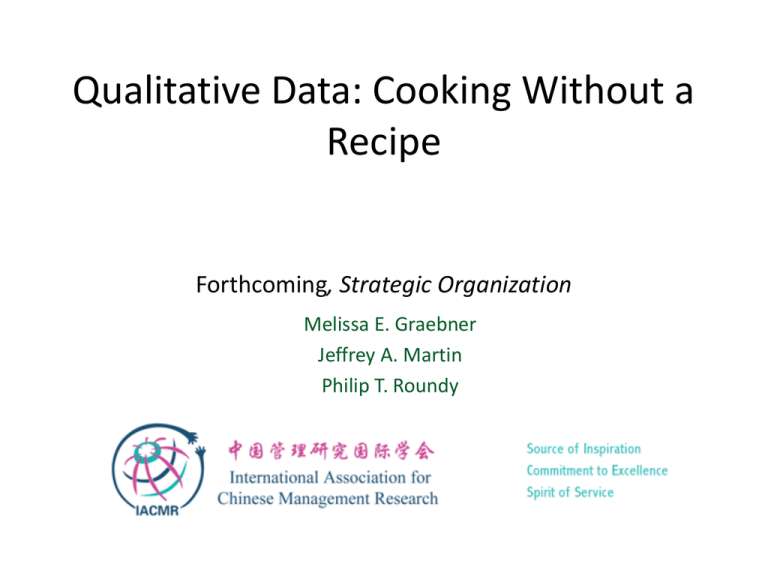
Qualitative Data: Cooking Without a Recipe Forthcoming, Strategic Organization Melissa E. Graebner Jeffrey A. Martin Philip T. Roundy Potential 潜力 2 Frustrations 挫折 ©Jeffrey A. Martin, PhD 3 Confusion 混淆 Many descriptions of qualitative research: • Lump all qualitative research together and offer lists of “typical” characteristics – – – – – – Nascent theory Naturalistic setting Inductive analytical approach Constructivist, relativist, interpretive stance Acceptance of researcher bias Interest in ordinary or everyday behavior • Or group into “categories” with their own “typical characteristics” No “recipe” or “cookbook,” but not “anything goes” “While qualitative methods need to be elaborated or modified for each new application, this does not mean that anything goes or that the best method is no method” (Gephardt, 2004, p. 458). This creates some dilemmas: 1. Many studies do not fit in a single school of qualitative research (e.g., Maxwell, 2005) 2. Few studies have all of the “typical” attributes Researchers may feel compelled to force their work to fit into a mold that isn’t appropriate A potential solution: Focus on why you are using qualitative data • There are multiple, distinct reasons for using qualitative data. • Understanding why you are using qualitative data helps avoid forcing your study to fit with an inappropriate paradigm • This reduces confusion and frustration How qualitative data are different 1. Open-ended 2. Concrete and vivid 3. Rich and nuanced Given these advantages, what research goals may call for qualitative data? New Theory Reason #1: Build new theory when prior theory is absent, underdeveloped, or flawed Reason #1: Build new theory when prior theory is absent, underdeveloped, or flawed • Advantage of qualitative data: open-endedness • Findings in a theory-building study can take diverse forms: – Variance predictions (e.g., Ozcan & Eisenhart, 2009) – Process models (e.g., Graebner, 2009) – Typologies that unpack important and poorly understood constructs (e.g., Hite, 2003) • And may be aimed at developing “objective,” positivist theory Lived experiences Reason #2: Capture individuals’ lived experiences and interpretations ©Jeffrey A. Martin, PhD 13 Reason #2: Capture individuals’ lived experiences and interpretations • Again, the advantage of qualitative data is openendedness • But there are important differences vs. theory-building: • Interpretive studies: – Aim to preserve the subjective nature of their data throughout the analytical process – May use qualitative data even when substantial prior theory exists • e.g., Creed et al.. use qualitative data to “complement and extend” previous theoretical work (2010: 1337) . Complex processes 15 Reason #3: Understand complex process issues • Phenomena involving complex temporal dynamics or causal mechanisms, often embedded in nuanced social interactions • Advantage of qualitative data: Richness • In practice, many process studies involve some theory-building – but qualitative data can also be used for process studies in areas of relatively mature theory – E.g. Martin (2011) – top management team processes; Lumineau et al. (2011) – organizational learning – Process researchers may even use qualitative data to test theory (e.g., Greenwood et al., 1994) Illuminate ©Jeffrey A. Martin, PhD 17 Reason #4: Illustrate an abstract idea • Advantage of qualitative data: Vividness, concreteness and richness • Example: Siggelkow, 2001. “The framework proposed in the paper emerged more from a conceptual exercise than from my exposure to Liz Claiborne’s experiences. However, the case turned out to be a very helpful illustration and was used in that manner after the conceptual framework was presented.” • Open-endedness is less important – these researchers may have well-developed models prior to gathering their data (e.g., Kauppila, 2010). Examine language Examine narratives, discourse or other linguistic phenomena ©Jeffrey A. Martin, PhD 19 Reason #5: Examine narratives, discourse or other linguistic phenomena • Phenomena that fundamentally involve words and language • May or may not be interested in individuals’ subjective experiences – May examine media accounts, annual reports, websites and press releases – And they may code their data in ways that enable statistical analysis – E.g., Martens et al.’s (2007) analysis of narratives in IPO prospectuses • Quantified narratives to test hypotheses using statistical estimation Why is this important? Identifying your reason(s) for using qualitative data can help with navigating the review process: 1. Writing the “front end” 2. Describing analysis 3. Addressing biases ©Jeffrey A. Martin, PhD 21 Writing the “front end” • Illustrating an abstract idea: expect a lengthy front end • Process questions, interpretive perspectives or language-related topics may also have a lengthy front end • Theory building studies may have a short front end, or a longer one that identifies specific conflicts or other problems in prior theory Describing analysis • Vast majority of qualitative studies describe their analysis as “inductive” – But in reality, they often use a blend of inductive and deductive processes – may choose certain constructs or theoretical frames prior to data collection – If using qualitative data for a reason other than building theory, no reason to expect a purely inductive approach Addressing biases • Qualitative authors need to convince reviewers they have minimized biases – Informant bias – Researcher bias • Identifying the rationale for working with qualitative data can help – For interpretive research, the greater risk may be researcher bias – For (positivist) theory-building research, the greater risk is likely to be informant bias • Can be addressed through multiple informants, focus on facts, triangulation with archival data, etc. In summary… • Qualitative data can serve a number of different purposes – – – – – Theory-building Interpretive perspective Process issues Illuminate abstract ideas Linguistic phenomena • Not all qualitative studies will look alike • Identifying the reason for working with qualitative data can help avoid minefields during review process Questions?

